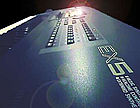| |
| SYNTHESIS
TECHNIQUES |
 |
| |
The
EX5 combines various tone generation techniques:
- AWM (Advanced Wave Memory) that provides an extensive range
of sampled sounds editable thru a wide filters range.
- VA (Virtual Acoustic Synthesis) to reproduce real acoustic
instruments sound (mainly winds and strings).
- AN (Analog Physical Modeling) to simulate the typical old
analog synthesizers sounds.
- FDSP (Formulated Digital Signal Processing) to improve
the sampled sounds realism or to create totally new effects.
Any EX5 voice (sound) can combine a maximum of 4 elements.
|
| AWM
(ADVANCED WAVE MEMORY) |
 |
 |
AWM
synthesis is based on 44.1 kHz and 16-bit resolution sampled waveforms.
The sounds include pitched voices which can be played on a musical
scale from low to high (i.e.: piano, trumpet) or a complete set of
drum/percussions sounds, each having a fixed pitch and being assigned
to individual notes of the keyboard.
Preset waveforms (419) are grouped in categories to facilitate the
selection during programming opearations.
EX5 can load waveforms or directly sample sounds (even though advanced
editing functions reveal some lack).
|
 |
Waveforms
can be played in various loop types (i.e.: Forward loop, Reverse,
etc.) and each one is provided with an individual Level, Pan, Detune,
Key Zone, Velocity, Cross-fade and Micro-Tuning. An extensive range
of resonant filters (static and dynamic) grant a powerful tone editing.
Each waveform can be processed by 2 dynamic filters (serial and parallel
settings available) with resonance control. The DCF can be controlled
by velocity sensitivity and EG.
The amplifier section includes a six Times and seven Levels EG. 2
LFO provide Vibrato, Wah and Tremolo effects.
In AWM sound editing, EX5 provides intuitive and well structured display
information. |
| |
|
VA
(VIRTUAL ACOUSTIC)
|
 |
|
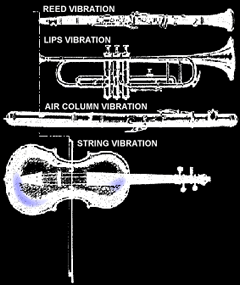
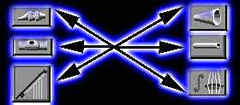


|
The
first VA (Virtual Acoustic Synthesis) synthesizer has been introduced
by Yamaha in 1994 (VL1).
Tone generation is based on mathematic algorithms, that reproduce
realistic winds, reeds and string instruments sounds.
In this type of synthesis, better known as Physical modeling, the
"instrument" defines the basic tone of the sound (see picture).
The "instrument" consists of 2 components: a Driver and a Resonator.
The driver simulates the sound generating vibration (es: reed/mouthpiece,
lip/mouthpiece or bow/string system), while the resonator is the resonant
element (trumpet flare, pipe, violin body, etc.).
The sound timbre is controlled by 2 sections: Controls and Modifiers.
The Controls section parameters allows the player to obtain effects
due to the tightness of the lips against the reed, the amount of breath
pressure applied to the reed or mouthpiece, the tonguing technique,
etc. (in wind instruments) or bow movement (in string instruments).
The Modifier section affects the harmonic structure of the basic sound.
VA synthesis provides also unusual combinations (i.e.: string controlled
by breath) allowing the creation of new sounds.
The EX5 mathematic algorithm is specialized in reproducing wind instruments
in a monophonic way.
That's why this synthesis is called VL (Virtual Lead).
Anyway, it must be pointed out that, due to the complexity of the
synthesis, EX5 VA section provides only preset sounds and effects
models (256).
These sounds can be edited thru 5-bands parametric EQ, dynamic resonant
filter, EG and LFO (this one just providing vibrato effect).
In order to better reproduce wind instruments, the use of a BC2 or
BC3 Yamaha breath controller, connected to the EX5 rear panel, is
suggested.
In this way, the player
can reproduce timbral variations in a more natural and instinctive
way. |
| |
| AN
(ANALOG PHYSICAL MODELING) |
 |
|
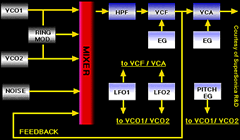


|
FDSP
can be considered as an hybrid synthesis, using both AWM and physical
modeling sound generation.
FDSP provides 10 algorithm. Some algorithm is useful to improve electroacustic
tones (Electric Piano and Electric Guitar) while others reproduce
classic (PWM, Phaser, Flanger) or unusual effects (Water, Tornado,
Seismic).
For instance, "EG pickup" effect can modify in a very sophisticated
way an electric guitar sound. Tonal changes, in fact, are due to pick-up
electromagnetic characteristics (single coil or humbucking) and position
or depend from picking position and distance between pickup and strings.
"EG pickup" effect parameters allow to change all the above mentioned
characteristics.
FDSP user interface is not immediate. Anyway, edit procedure is not
very complex: interesting results can be obtained.
The drastic polyphony reduction (maximum 16 notes) is the main disadvantage. |
| |
| FDSP
(FORMULATED DIGITAL SIGNAL PROCESSING) |
 |
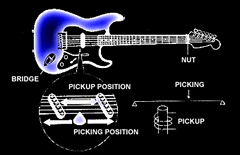 |
FDSP
can be considered as an hybrid synthesis, using both AWM and physical
modeling sound generation.
FDSP provides 10 algorithm. Some algorithm is useful to improve electroacustic
tones (Electric Piano and Electric Guitar) while others reproduce
classic (PWM, Phaser, Flanger) or unusual effects (Water, Tornado,
Seismic).
For instance, "EG pickup" effect can modify in a very sophisticated
way an electric guitar sound. Tonal changes, in fact, are due to pick-up
electromagnetic characteristics (single coil or humbucking) and position
or depend from picking position and distance between pickup and strings.
"EG pickup" effect parameters allow to change all the above mentioned
characteristics.
FDSP user interface is not immediate. Anyway, edit procedure is not
very complex: interesting results can be obtained.
The drastic polyphony reduction (maximum 16 notes) is the main disadvantage. |
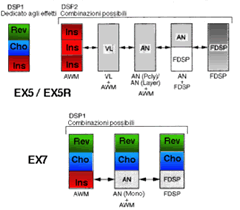 |
EX5
and the correspondent EX5R rack version feature 2 built-in DSP (Digital
Signal Processors).
The top of the picture on the left shows that DSP 1 is always dedicated
to effects creation. 3 blocks are available: 2 are dedicated to reverb
(12 types) and chorus (17 types) effects with independent send; the
third block provides various insert effects (Insert 1 = 24 types;
Insert 2 = 79 types).
DSP 2 can be used to create effects, but alternatively is also used
to create AN, FDSP and VL voices. In this case DSP2 works in parallel
or series with the AWM generator. When DSP 2 is used in sound generation,
EX5 polyphony may change.
The EX7 version (61 keys with a built-in 64 notes polyphony AWM tone
generator) doesn't feature DSP 2. Being available a single DSP, EX7
provides only AWM, AN e FDSP synthesis, as shown in the lowest part
of the picture.
|
| |
| SYNTHESIS
TYPES COMBINATIONS |
 |
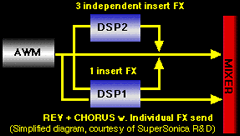 |
Synthesis types can be combined in various ways.
AWM SYNTHESIS
The simplest possibility is the pure AWM synthesis.
In this case up to 4 elements can be mixed and sent to the DSPs, each
one acting as an insert effect or with separate send.
The maximum polyphony available is 126 notes. |
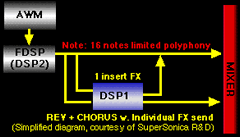 |
FDSP
or AN+FDSP SYNTHESIS
DSP 2 is also involved in FDSP synthesis.
In this case, two possibilities are available:
- FDSP synthesis: DSP 2 is completely dedicated in up to 4 AWM elements
processing. In this case, due to the DSP 2 processing, the maximum
polyphony is 16 notes;
- AN + FDSP synthesis: DSP 2 is partially dedicated to AN tone generation
and to FDSP effects production.
In this mode, maximum polyphony is 1 AN voice + 8 FDSP voices. |
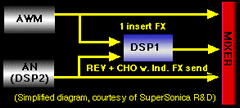 |
AN+AWM
SYNTHESIS
Another possibility is the combination of AN + AWM.
In this case, DSP 2 generates only AN sounds with a polyphony of 1
or 2 notes, depending on the mode selected (mono or polyphonic).
AN sound can be combined with a maximum of 3 AWM elements that provides
a maximum 126 notes polyphony. |
|
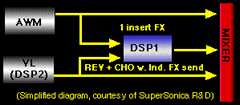
|
VL
or VL+AWM SYNTHESIS
Finally, DSP 2 can be totally dedicated to VA synthesis.
In this case the sound generated is always monophonic, but it can
be combined with a maximum of 126 notes provided by AWM synthesis
(VL + AWM). |
|
 |



